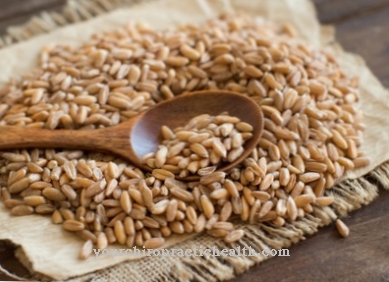The Broad bean, also known by numerous other synonyms, is mainly used as a protein carrier in cattle feed.
In Germany, the field bean, whose precursors were known in the Middle East for at least 8,000 years, plays a very different role in terms of human nutrition. There is some evidence that the bean could experience a renaissance in the future - as in the Middle Ages - as an important source of protein for human nutrition.
What you should know about the broad bean

The origins of the annual, herbaceous, field bean (Vicia faba), which is also known under numerous synonymous names such as thick bean, broad bean, Broad bean and some others are known to go back to at least the 5th millennium BC. BC as archaeological finds in Israel, near Nazareth attest.
The wild form, to whose further breeding the cultivated broad bean goes back, is not exactly known. The bean belongs to the legume family (Fabaceae or Leguminosae). In the Middle East, the field bean reached a smaller form than it does today from the 3rd millennium BC. Apparently widespread. From the Middle Ages to the 17th century, the broad bean played an important role in supplying the population with important proteins and essential amino acids as one of the staple foods in Central Europe.
From the end of the 17th century, the field bean was more and more displaced from the menu in Central Europe by the potato, which originally came from Central and South America, so that its use as fodder or as so-called green manure came back to the fore. The field bean has a high water requirement during the growth phase and, due to its relative resistance to frost, can be sown as early as February at a soil temperature of 2 to 3 degrees. In regions with mild winters, perennial varieties can be used and they can be sown as winter crops as early as late autumn. In order to achieve better and deeper roots, the seed beans are placed 10 to 15 centimeters deep in the ground.
The harvest season starts in June. The main harvest season for fresh broad beans extends from June to August. However, outside of the season nobody needs to go without fresh beans because they are also offered in their natural state as frozen food. Dried field beans, which are also available in grocery stores all year round, offer an alternative to frozen food. However, these must be soaked overnight before consumption.
The main reasons for a possible renaissance of the broad bean for human nutrition are its high content of proteins with valuable amino acids, its content of minerals and some B vitamins such as pantothenic acid and niacin. In addition, the broad bean is not only interesting for its health aspects, it is also valued for its pleasant and distinctive taste.
Importance to health
The health aspects of the broad bean, which can be traced back to its ingredients, are complex. Not only does the isolated effect of individual components play a role, but also the overall effect that results from the synergetic interaction of all components.
For example, field beans with a nutritional and calorific value of 88 kilocalories per 100 grams achieve a considerable value, which is mainly based on the carbohydrate content of approx. 45 to 60 grams. Nevertheless, the consumption of beans is completely harmless in terms of weight gain, because they also provide a high proportion of fiber, which ensures that the carbohydrates are only gradually available in the course of the digestive process. The carbohydrates prepared by the body with a very low glycemic value trickle into the blood, so to speak, and thus ensure a lasting feeling of satiety.
In contrast to this, after consuming sugar, the glucose literally shoots into the blood with all the consequences for the insulin and fat metabolism and the quickly resuming feeling of hunger. The health-promoting aspects also refer to the proteins contained, which contain valuable and in some cases essential amino acids. In addition, field beans - like other legumes - offer oxidative protection, which contributes to preventive protection against certain types of cancer. In the intestine, it is above all the dietary fiber that, in combination with fermenting bacteria, helps to reduce the risk of colon cancer.
Ingredients & nutritional values
| Nutritional information | Amount per 100 gram |
| Calories 88 | Fat content 0.7 g |
| cholesterol 0 mg | sodium 25 mg |
| potassium 332 mg | carbohydrates 18 g |
| protein 8 g | Fiber 8 g |
Field beans have a considerable portfolio of health-related primary and secondary ingredients. Their relatively high nutritional value of 88 kilocalories per 100 grams is coupled with a low glycemic index, which ensures that the long-lasting feeling of satiety after consuming field beans supports weight loss rather than weight gain.
The high protein content of up to 30 grams per 100 grams is particularly striking. The proteins provide important amino acids and peptides for a multitude of metabolic processes. These are full-fledged proteins with the exception of sulfur-containing amino acids such as methionine and cysteine, which broad beans do not offer. As a supplier of minerals, field beans also offer a well-stocked arsenal with high concentrations of potassium, calcium and magnesium. In terms of vitamins, there are especially vitamin A, some B vitamins and vitamin E, which are absorbed and used by the body after consumption. Only vitamin C is only available in irrelevant concentrations in field beans.
Intolerances & allergies
In Central Europe, around one percent of the population suffers from a hereditary deficiency in G6PD (glucose-6-phosphate dehydrogenase), which is caused by a gene mutation on a locus on the X chromosome. It is an enzyme that intervenes in the sugar metabolism and whose deficiency can lead to haemolysis, i.e. to the destruction of the red blood cells, after consuming the broad bean or when the pollen is inhaled.
The symptoms of the disease, which is called favism, occur only very rarely when eating cooked field beans - which should be the normal case. The carbohydrates in the form of starch found in field beans are gluten-free, so that people who suffer from gluten intolerance can enjoy field beans without any problems.
Shopping & kitchen tips
When buying fresh broad beans, it should be noted that they should only be kept in the vegetable compartment of the refrigerator for 3 to 4 days. Outside the harvest season, frozen or dried broad beans offer an alternative.
In order to be sure that you are buying an unpolluted food, various organic qualities can be found in stores. To prepare a dish for gourmets, the fresh broad beans can also be blanched for one to two minutes in boiling salted water and then quenched in ice water to remove the inner kernels from the skin and process them as a delicacy. The same procedure is recommended before preparing frozen beans.
Preparation tips
After preparing the fresh broad beans as described above, the kernels only need a short cooking time of a few minutes to serve as an excellent accompaniment to various fish and meat dishes after seasoning with savory or parsley. Hearty one-pot dishes can also be prepared very well and tasty using field beans and other ingredients. An Italian specialty is a kind of bean and tomato vegetable with sheep cheese.












.jpg)

.jpg)
.jpg)











.jpg)